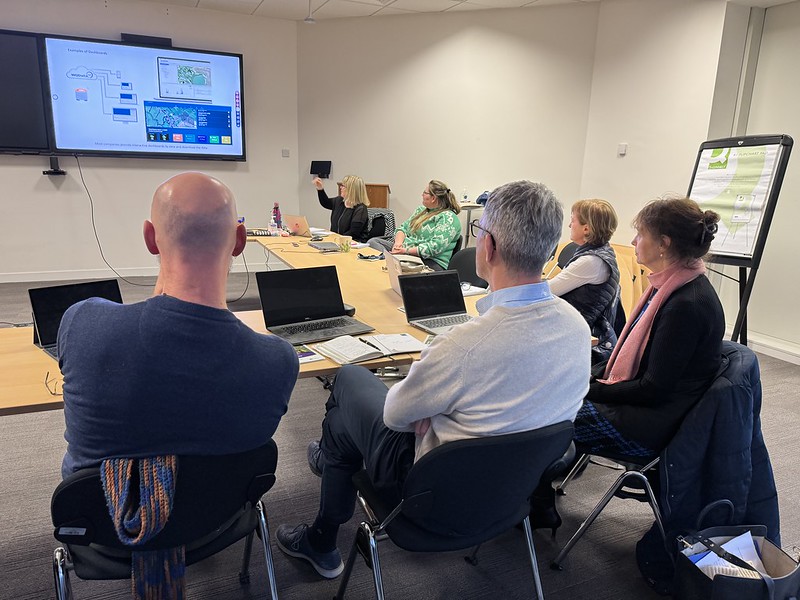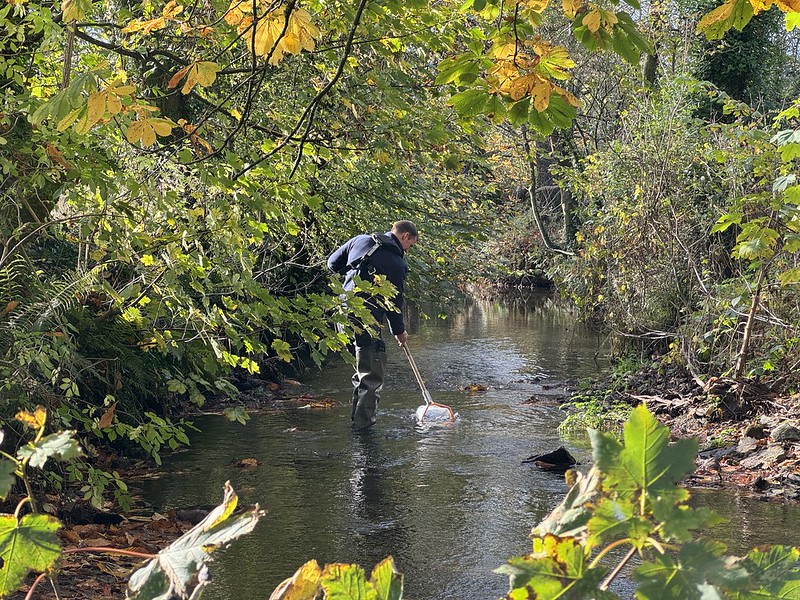
Waters of LIFE and RESTORE Plan Monitoring Programme For Project Sub-Catchments
Members of the Waters of LIFE and RESTORE projects met at Inland Fisheries Ireland HQ to review a programming draft for 2025.
19/02/25
The work of both projects are closely aligned. The focus of Waters of LIFE is on the implementation of measures to protect and improve water quality. RESTORE are responsible for a multidisciplinary monitoring programme that assesses the impact of those measures.
The teams came together on St. Valentine’s Day to discuss their approach to measures and monitoring in the five Waters of LIFE demonstration sub-catchments. The planning output of the meeting will be finalised and published later in the spring.
RESTORE completed a baseline assessment of water quality in the sub-catchments in 2024 ahead of rolling out an active monitoring programme in 2025. Many of the same assessment sites will be used again to detect changes based on the broader issues and pressures affecting each sub-catchment.
A summary of sites used for the baseline assessment will be available on www.watersoflife.ie by May 2025.

RESTORE’s programme will also adopt a more targeted approach to monitoring in the sub-catchments.
Forestry will be a key focus in the Avonmore (Wicklow) and Graney (South east Clare and Galway) demonstration sub-catchments. Monitoring sites will be identified upstream and downstream of areas of active forestry. This will help with the projects’ assessment of impacts and mitigations for this type of activity. Targeted silt traps will be one of the tools used in monitoring.
Targeted silt trapping will also feature in the monitoring programme for the Islands demonstration sub-catchment in north east Galway and west Roscommon. Fine sediment was identified as an issue in the Local Water Authorities Programme (LAWPRO) assessment of the area.
The Waters of LIFE agri-environmental programme pilot received over 350 expressions of interest across the Avonmore, Awbeg (Kilbrin), Graney, Islands and Shournagh sub-catchments in late 2024.
The EU-funded LIFE project will be meeting with eligible farmers and offering contracts to participate in its programme in February and March 2025. The number represents about 25% of all local farmers.
The Waters of LIFE pilot agri-environmental programme funds farmers to implement measures that enhance local habitats to protect and improve water quality. Farmers will also be able to access the results of their mitigation efforts through localised monitoring sites.

This information will be offered in the Awbeg (Kilbrin) and Shournagh in Cork as well as the other sub-catchments.
The expanded monitoring programme will also look at lakes. Lough Graney and Lough Atorick are features of the Graney sub-catchment while Lough Dan and Lough Tay are well known to everyone in the Avonmore sub-catchment. The presence of sediment and zooplankton in lakes tells an important story about the history and water quality of the wider sub-catchment.
Monitoring tools for RESTORE fall into three categories: Biological, chemical and hydro morphological. Each sub-catchment will have its own bespoke monitoring programme using a range of these tools. Local weather stations will also be installed in some sub-catchments. Weather stations help to match the flow in water bodies with localised information about rainfall and other weather and climate events.
Waters of LIFE will produce resources to explain these types of monitoring tool over the lifetime of the project. They include:
Biological Sampling:
Biological sampling helps to detect changes in composition, abundance and diversity of aquatic wildlife and offers deep insights into local ecological status. Each biological community has its own indices/metrics which can be used to identify changes in ecological status. This is done by sampling such as the following:
Macroinvertebrates using tools such as Small Streams Impact Score (SSIS) and Acid Water Indicator Communities (AWIC) to look at ecological health;
Macrophytes using tools such as MTR (Mean trophic Rank) to look at eutrophication, oxygen levels, pollution sensitivity, pH changes and habitat alteration;
Phytobenthos (microalgae) using Trophic Diatom Index (TDI). These help to monitor eutrophication and nutrient levels; organic pollution and the decomposition of organic matter (saprobity); pH and acidification; hydro morphological changes to flow and substrate quality;
Zooplankton for eutrophic and oligotrophic changes; organic pollution; oxygen levels; predation pressures and food web shifts.
Chemical / Nutrient Analysis:
Chemical analysis can be both broad and targeted within a sub-catchment. Project tools and methods will include:
Grab samples for nutrient and dissolved organic carbon (DOC) analysis;
A mix of high frequency multi-parameter and single parameter devices;
Automatic water sampling allow for water samples to be taken at pre-determined intervals to assess water quality during a range of flows and suspended sediment discharges including storm flushes and flood events.
Hydro-morphological:
Hydro-morphology refers to the form, flow and function of a river and is an important indicator for water quality. Monitoring tools include:
RHAT (River Hydromorphology assessment technique)/ MoRPH (Modular River Physical ) Surveys;
Quorer method for broad sampling of continued deposited and suspended sediment sampling;
Silt Trapping for targeted sampling to measure the impacts of localised mitigation measures and point sources.
Details of the sub-catchment monitoring programme will be outlined later in the spring.